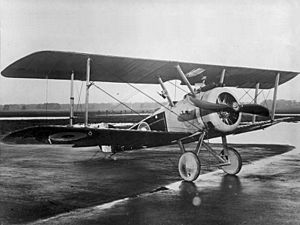Harold Stackard facts for kids
Quick facts for kids
Harold Francis Stackard
|
|
|---|---|
| Born | 2 March 1895 Norwich, Norfolk, England |
| Died | 24 November 1949 (aged 54) Fittleworth, West Sussex |
| Allegiance | |
| Service/ |
|
| Years of service | 1914–1918 |
| Rank | Lieutenant |
| Unit | Royal Naval Division No. 9 Squadron RNAS No. 157 Squadron RAF |
| Battles/wars | First World War |
Lieutenant Harold Francis Stackard (born March 2, 1895 – died November 24, 1949) was a brave British pilot during World War I. He was known as a "flying ace" because he shot down 15 enemy aircraft. Besides being a pilot, he also taught other pilots in the Royal Air Force.
Contents
Early Life
Harold was born in Norwich, England, on March 2, 1895. His parents were Stephen and Mary Ann Lydia Pipe Stackard. He was the second of five children in his family. When he was young, his family lived in Norwich. Later, they moved to Muswell Hill, a suburb of London. His father made glass bottles for a living.
Becoming a Pilot
Harold first joined the Royal Naval Division in the military. He served on a ship called HMS Oratava. He fought in France in 1914 and Gallipoli in 1915. In October 1916, he joined the Royal Naval Air Service to become a pilot. He became a Flight Sub-Lieutenant in December 1916. During his training, his plane, a Bristol Scout, had a small accident when landing.
After his training, Harold spent eight months fighting on the Western Front. He flew with No. 9 Squadron of the Royal Naval Air Service. Even though he served for four years and was wounded, he was credited with 15 aerial victories.
First Victories
Harold Stackard achieved his first victory on May 2, 1917. He was flying a Sopwith Pup, a single-seat biplane. He destroyed an enemy two-seat aircraft over Middelkerke, Belgium. He shared this victory with another pilot, Harold Mott.
However, on May 4, 1917, Harold's plane was shot down. He crashed northeast of Ypres. On May 31, 1917, while flying a Sopwith Pup, he made an enemy two-seater plane go out of control over Ostend, Belgium. He shared this success with Flight Commander Fred Banbury and Flight Sub-Lieutenant Shearer.
Harold scored his third victory on June 8, 1917. He was flying a single-seat Sopwith Triplane. He sent an Albatros D.III plane out of control over Diksmuide, Belgium. On June 14, 1917, it was reported that Harold was wounded. This might have been from the crash in May.
More Victories with the Sopwith Camel
Harold's next 12 victories were all achieved while flying Sopwith Camel aircraft. These were single-seat biplanes. His fourth victory was on September 3, 1917. He destroyed an Albatros D.III southeast of Pervijze, Belgium. He shared this with Joseph Fall, J. E. Scott, and Arthur Wood.
The very next day, September 4, he destroyed a DFW C plane over the Nieuwpoort-Middelkerke area. This was his fifth victory, shared with Joseph Fall and J. E. Scott. Harold had his sixth triumph on September 6, 1917. He drove an Albatros C plane out of control over Middelkerke. He shared this with Arthur Wood, Hazel Wallace, J. E. Scott, and Joseph Fall.
Harold achieved his seventh victory on September 9, 1917. He was flying his Sopwith Camel. He sent an Albatros D.V plane out of control east of Middelkerke, with help from Joseph Fall.
Double Victories
Pilot Stackard scored two victories on the afternoon of September 11, 1917. He was flying his Sopwith Camel. He destroyed two Albatros D.V aircraft over Leke, Belgium. One of them caught fire. He shared both of these victories with Joseph Fall and Arthur Wood.
His tenth victory happened on September 13, 1917. He sent another Albatros D.V out of control east of Leke. He shared this with Flight Sub-Lieutenant Stearne Edwards. He scored another two victories on September 24, 1917. First, he sent an Albatros D.III out of control over Leke, shared with Joseph Fall and Arthur Wood. Then, he drove an Albatros D.V out of control over Middelkerke.
On September 30, 1917, Harold achieved yet another two victories. He was still flying his Sopwith Camel. South of Middelkerke, an Albatros C was destroyed. About an hour later, another Albatros C was sent out of control. The first one that day was shared with Joseph Fall and Arthur Wood. Harold's fifteenth and final victory took place on October 27, 1917. He sent an Albatros D.V out of control, shared with Stearne Edwards and others.
After Combat Flying
By 1918, Harold was an instructor at RAF Cranwell in Lincolnshire. On January 2, 1918, he was promoted to Lieutenant. Harold Stackard later transferred to No. 157 Squadron of the Royal Air Force. This squadron was formed in July 1918. He had the chance to fly the Sopwith Salamander fighter plane. This plane was designed for ground attacks. However, the war ended before the Salamander was used in battles.
After the War
On November 7, 1920, Harold Francis Stackard married Ruth Mary Savage. She was from Winchester. Harold later became a branch manager for an insurance company called Commercial Union Assurance Company. He worked in Calcutta, India. Harold Stackard passed away at age 54 on November 24, 1949. He died in Fittleworth, West Sussex, England. His wife lived for almost 46 more years, passing away at the age of 100.
Gallery of Aircraft Downed
See also
- Aerial victory standards of World War I







